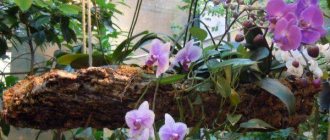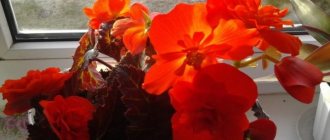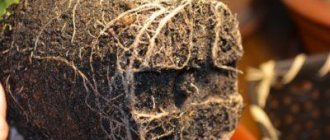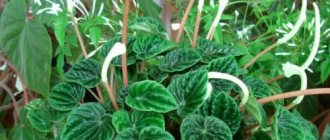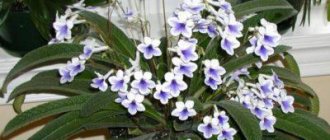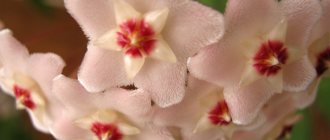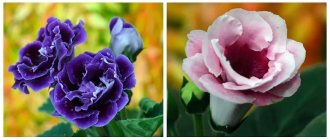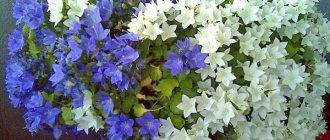What kind of flower is this?
Gloxinia brocada are subshrubs belonging to the Gesneriaceae family . This plant has a tuberous rhizome.
Gloxinias vary in rosette size, for example, there are microminiature, the radius of the rosette usually does not exceed 5 mm, miniature, where the radius of the rosette reaches 20 mm, semi-miniature, where the radius varies from 20 to 30 mm, and standard, where the radius exceeds the size of 30 mm.
Gloxinia brocada is a miniature plant. The birthplace of the flower is South America. And to be more precise - Brazil. It was in this country that the plant was discovered in 1785, and botanists called it speckled gloxinia. Surprisingly, the flower also has the name Sinningia .
Reference! Gloxinia owes its origin to two botanists – doctor Gloksin and Sinning. It was in their honor that this creation of nature was named. And now, thanks to the efforts of breeders, work has been going on for 200 years, due to which more and more new varieties of these wonderful flowers are being born. The result is also clean, rich petal colors.
Varieties, varieties, photos of terry gloxinia
Not only scientific botanists are engaged in plant selection, but also ordinary people who love gloxinia and plant it at home. The flowers are quickly pollinated, producing bells of unusual shapes and amazing shades.
The crimson and purple colors were replaced by snow-white and pinkish tones; varieties appeared with contrasting borders, polka dots and spots, and chintz.
It’s impossible to get enough of the double flowers; the petals arranged in rows make them look like roses.
Avante varieties are distinguished by an abundance of shades. The bush has a neat rosette of leaves and elegant velvety flowers. Breeders have developed Avanti varieties, including:
- Light Violet purple color;
- White – with white petals and wavy edges;
- Blue lace (Blue) – with a light border;
- Scarlet - with dark red bells.
Dutch breeders have developed a hybrid with a beautiful name, which is grown in many countries.
Terry gloxinia with the female name Yesenia, which is a real miracle, has a height of about 30 cm. Catchy flowers form above the emerald rosette. Pink buds give way to crimson flowers, and a snow-white outline flaunts along the edges of the petals.
Hybrid Hollywood has a bright lilac color and delights with lush velvet flowers, the lemon neck of which is dotted with purple dots. This gloxinia variety is characterized by simple petals, a small rosette of leaves, and an original shape of shoots.
One of the varieties is Black Hollywood , the name of which refers to its color.
The bells of the Kaiser Wilhelm hybrid have a thick purple hue, which becomes less saturated in the light. The middle is covered with spots, surrounded by a white border. Tall flower stalks rise above the velvety leaves.
Prince Albert enchants with its beauty and surprises with its unusualness . The bush immediately produces 6, and sometimes more, large buds. When they bloom, dark purple flowers appear with a wavy rim, which have a bluish tint in the sun.
Kaiser Friedrich is formed from 5 bright crimson petals, decorated along the edge with a white wavy border. The creamy neck is covered with small specks. The diameter of one bell reaches 10 cm, despite the fact that the plant itself is no higher than 20. It has velvety leaves, and a delicate aroma emanates from the flowers.
White terry gloxinia is particularly elegant. The miniature emerald bush has large, delicate flowers; the neck has a lemon tint. Among the varieties of this group, Blonde Giselle .
The straight stems of the hybrid plant are covered with delicate fluff. Light veins appear on the large dark leaves.
The bells have a diameter of about 10 cm, the snow-white petals are decorated with small pink or purple specks.
Blanche de Meru differs from other hybrids in its enlarged rosette of velvety leaves, a contrasting combination of crimson color with a white center. With proper care, buds will form on the shoots until September.
Among the bred hybrids, the plant most closely resembles the wild Gloxinia Vialacea, which can still be found in the rocks of Latin America.
Attention! The blossoming dark lilac bells with purple specks on the throat have a diameter of no more than 8 cm, they are formed on a peduncle of considerable height, so the shoots of the plant break without support.
Terry Shagane was obtained by breeder from Stavropol Elena Slyusar. Gloxinia is distinguished by light leaves, white bells with small purple peas.
A blue border frames the corollas; some petals have specks. They come in different sizes and differ in brightness. This tiger will elevate any room.
Cleopatra surprises with her chintz coloring. Terry bells are white, as if powdered with small peas - purple and pink.
On the corrugated edges of the petals, the pattern becomes lighter. The original shape of the plant has large leaves, the lower ones form an elegant frill.
The snow-white Madonna's flower looks like a rose. The petals of the terry beauty, arranged in rows, end with a fringe, which is why it looks especially elegant.
In the sun, streaks of scarlet appear in the buds. The inner side of the dense leaves is purple in color.
Attention! Even inexperienced gardeners can grow gloxinia variety Madonna. It multiplies quickly and grows well.
Terry bells Marionettes , framed with snow-white canvas, covered with specks - scarlet and lilac, look original and have a special charm.
The crimson flowers of the Madame Margaret hybrid have wavy edges. They are often framed by a thin white stripe. The buds form bright bouquets.
The minx appeared thanks to the work and imagination of a young breeder from Russia, Sanin. The delicate pink and cream petals of the flower are arranged asymmetrically. They have a contrasting border - scarlet and white. The plant amazes with its variety of shades, forms up to 10 buds at the same time, and has an aroma like a peach rose.
May Queen has beautiful silver-veined leaves. The petals of small bells are surrounded by a bright stripe that turns into specks.
Blue brocade amazes with the beauty and quantity of double cornflower blue flowers, of which up to 25 are formed on a medium-height bush. The plant has large leaves that differ in their original shape.
Brocade red surprises with its abundant flowering of bells up to 6 cm in diameter, in bright shades. Some hybrids have a white outline, while other gloxinias do not, but because of this the plant does not lose its elegance.
Having seen gloxinia in the photo, many housewives are interested in how to care for it, that it gave such beautiful flowers.
Varieties
Blue
Gloxinia blue has double flowers, the diameter of which reaches 8 cm, usually blue or purple with a thin and neat white border. The bush itself reaches a height of 20 cm, where from 10 to 25 large double inflorescences grow.
Red
Gloxinia red is a profusely flowering and beautiful plant with small flowers, the diameter of which reaches 6 cm. The color is bright red, the border predominates or is absent. The bush size is usually 20 cm.
Do you want to know what are the main differences between Tydea and Gloxinia? Also see materials on growing other types of synningia: Krasnoyarsk, climbing, hybrid, Rosalind, Sonata, White Terry, Kaiser Wilhelm and Friedrich, as well as pink.
Caring for gloxinia at home
In order for this amazing flower to grow comfortably on your window, it needs to be provided with certain conditions. The absence of drafts, maintaining the desired temperature, proper transplantation and care will allow gloxinia to bloom profusely to the delight of the owner.
How to plant
The seeds of this flower are microscopic in size. For this reason, they go on sale only in protective shells, which are also the first feeding. For sowing you will need a special container and peat soil. And the process itself is performed in the following sequence of actions:
- The soil is first moistened, then the seeds are placed in it. The distance between them should be 3 cm. Plant the seeds in moist soil
- To allow seedlings to germinate, the planting material does not need to be sprinkled with soil on top.
- To create the required level of humidity, the crops are covered with glass. Place the container in a warm place. Cover the seeds with film or glass
- The soil is periodically moistened with a spray bottle so that it does not dry out.
- After 3-4 months, when the seedlings grow, become stronger and a pair of leaves appear on them, the plant is transplanted into pots.
After the seedlings emerge, they need to be transplanted into pots
External description of the plant
Gloxinia is a rather interesting flower. Its undoubted advantage is the presence of various leaf shapes, but in particular these are large leaves of juicy green or dark green color.
Gloxinia brokada is a terry variety. It is divided into several types, which depend on the color of the petals: calico, plain and tiger. Single-color buds have only one shade, calico buds are characterized by dots of different sizes, and brindle buds are characterized, in addition to specks, by rims on the edge of the petals.
Gloxinia brocade flowers are a single color. Magnificent flowers with bright buds rise above the dark green leaves, forming a ball shape, making the bush seem lush. That's why they are called double - they have several rows of petals, which is why the bush seems rich in flowers. And indeed it is.
What does Gloxinia Brocada Red look like?
“They will definitely respond negatively if they are not watered correctly,” he warned. “It’s important not to overwater. Water them when the soil feels dry to the touch. You can also water the plant from below - underwater - by placing the pot in a saucer of water and removing it after about an hour.
“Underwatering Gloxinias is a good idea because the plant's crown is very sensitive to excessive moisture and is prone to rot. Do not use cold water for irrigation. Be sure to use warm water, as this plant is sensitive to cold water. Finally, don’t let water get on the leaves when watering.”
Fertilization in moderation with a well-balanced houseplant fertilizer also benefits Gloxinias. Fertilizer needs are highest when the plant is actively growing and flowering heavily.
Peculiarities
The peculiarities of Gloxinia brocade begin with the flower itself, because the plant has a fairly small compact rosette, and thanks to this the buds look quite large. The color of the plants is usually uniform, but sometimes there is a border of a lighter shade than the petals.
The petals are like velvet both in appearance and to the touch. Gloxinia brocade flowers are one of the most persistent flowers that last a long time on the peduncle itself. The undoubted advantage of this plant is its abundant flowering. In one cycle, the plant can bloom up to 25 buds .
Gloxinia Kaiser Wilhelm and Winter Cherry
A very popular variety is Gloxinia Kaiser Wilhelm. He is loved very much for his unpretentiousness. This flower grows quickly and can adapt well to any changes in the surrounding microclimate. This is an excellent option for beginning gardeners.
Kaiser Wilhelm is distinguished by a large number of fleshy leaves that form a voluminous bush. The only drawback is the late flowering of this plant. Gloxinias of this variety usually begin to bloom only in the third or fourth year of life. But on the other hand, they produce a lot of buds at once, which is why a profusely flowering, bright bush develops.
The flowers of this plant have a very rich dark purple color. At the same time, a white border with a sharp transition is clearly visible along the edges. It all looks elegant and beautiful. Moreover, the petals are very velvety and soft to the touch.
One of the most beautiful types of terry gloxinia is Winter (Frosty) Cherry. This plant is distinguished by large white flowers that are covered with red or dark burgundy dots. It looks just great in a bouquet.
But caring for this variety is somewhat more difficult. The correct temperature and lighting are of great importance for the plant. Too bright light or excessive shadow - all this has a bad effect on the condition of the plant. At the same time, the flower reacts very sharply to excess moisture in the soil.
This gloxinia usually blooms in the spring, ending flowering in mid-summer. At the same time, even an adult plant looks quite compact, but at the same time very lush. This is all thanks to the thick stems and leaves of Gloxinia Winter Cherry, variegated flowers that are located quite close to each other.
How and where to plant?
To grow this beauty, you need bright and diffused light, the main thing is that its rays do not fall directly on the future plant. Gloxinia has fairly small seeds. For sowing them, loose soil is used, the composition of which is turf soil, humus, sand and leaf soil in a ratio of 1: 1: 1: 2.
Before sowing, the soil is disinfected. After which it needs to be watered. Planting is usually carried out from the end of February to March. Seeds are carefully placed in a greenhouse container at a distance of 3-5 cm. The crops are covered with film or glass in order to maintain moisture. The soil must contain nutrients, allow air to pass to the roots of the future flower and not retain water. The container is placed in a warm place. Seeds should not be planted at temperatures below 24 degrees. The soil is usually moistened, this needs to be monitored.
After the first true leaves have formed, the gloxinia should be planted in separate pots. An overgrown tuber of a plant must stick out a little from the ground. When watering the future flower, you do not need to touch the leaves.
Advice! It needs to be grown until 3 true leaves are formed. This means that gloxinia should be picked. Usually the leaves grow after 4 months from sowing. At the same moment, the flower tuber also grows.
The best watering option is from below. Water must be poured not into the flower pot itself, but into a saucer placed under the pot in advance.
You also need to water in moderation so that the soil does not become waterlogged. The most necessary things for successful flowering are lighting, warmth and humidity. After 6-7 months, when the tuber has already formed and the required number of leaves has been formed, Gloxinia Brocade blooms, although not so profusely.
Only 2-3 flowers are formed on a bush, but this is already a huge achievement. An already sufficiently formed adult plant produces about 25 buds.
Reproduction by peduncle
Gloxinia propagation includes another method - the use of peduncles. The advantages and disadvantages of this option were written at the very beginning of the article, so it’s worth moving on to a description of the technique.
For planting, flowers that have passed the flowering phase are used; the method itself is similar to how a new plant is obtained from leaf cuttings.
For your information. A number of varieties take root quite well, while others do not. The first include bell-shaped varieties, the second include terry varieties.
Reproduction by peduncles
The step-by-step instructions are as follows:
- Prepare a container of suitable size.
- Settled, non-cold water is poured onto the bottom to a height of 1 cm.
- The peduncle is trimmed together with the cutting part.
- Place in a container.
- If pollination of a flower has occurred, sprouts will soon appear. If this process does not exist, you will have to wait.
- After the root system appears, transplantation into the ground is carried out.
The article allows you to familiarize yourself with various options for propagating a beautiful houseplant. By choosing the option you like, every flower lover can get gloxinia, subject to the right recommendations.
Care
The most important feature of gloxinia is that it does not require special care. But still, the rules for successful flowering exist for it, and they must be followed so that the bush is lush, beautiful and pleasing to the eye. The optimal temperature should not exceed 25 degrees.
When the temperature drops, the leaves of the plant droop down and the flower “falls asleep.” As the temperature rises, the leaves tend to rise.
Air humidity should not be high, but gloxinia does not like drafts. When dry, unsightly brown spots form on the leaves. But you should not spray the plants, as this may cause rot. Fertilizers are used both ready-made and directly made independently. The supply of fertilizer is usually stopped in August.
The flower should be fed once a week or 10 days during active growth , a month after Gloxinia Brocade was planted or transplanted into new soil.
Seed method
But if you want to become like a breeder and develop your own unique hybrids, you can start breeding flowers from seeds. The generative method of reproduction is a rather long and labor-intensive process, but it has its advantages:
- The florist will be able to become the owner of a rare variety, since flower shops offer a wide selection of seed material.
- With this method of breeding, it is possible to feel like a breeder, having received your own hybrid
How to get gloxinia seeds at home
Original gloxinia seeds can only be obtained through artificial pollination and subsequent collection. The whole procedure looks schematically as follows:
- During flowering, pollen from the stigma of the female flower is transferred to the pistil of the male flower.
- After a few days, the corolla wilts, in place of which a seed pod is formed.
- Seed collection, depending on the variety, is carried out 1.5-2 months after signs of capsule opening appear.
Diseases
Gloxinia, unfortunately, like all plants, is susceptible to diseases. Ascochyta blight is the most common fungal disease that occurs when humidity increases. Red, brown or brown scary spots form on the leaves.
Damaged leaves are removed, after which the plant is treated with copper sulfate and this procedure is repeated a week later.
Late blight is the most dangerous fungal disease for gloxinia . It is terrible because it affects all parts of the plant.
A moldy coating begins to appear on the leaves, they dry out when dry and begin to rot when the humidity rises.
Brown stripes form on poor stems. Another common fungal disease is septoria. Gray or gray-red spots appear on the leaves of gloxinia, the stems and shoots dry out and bend. Saving the flower in this case is quite difficult. Many people make the mistake of starting to manually tear off and pull out damaged shoots. This can lead to the rapid death of the plant.
Important! The disease occurs due to the fact that air humidity is high, the plants are placed too densely, the gloxinia soil is quite dense and the soil mixture has not been disinfected.
Gloxinia brocade is also susceptible to diseases such as gray rot, powdery mildew, which is also a fungal disease, downy mildew, and thrips.
Diseases and pests
Under unfavorable growing conditions and the grower’s failure to comply with agrotechnical rules, the plant’s immunity weakens, and it begins to get sick and be attacked by pests. The most common disease is ascochytaosis. Develops against the background of abnormal infection by a pathogenic fungus with excessive humidity. Septoria and late blight are also common. Symptoms - leaf blades become stained, dry out and rot. For treatment, you need to remove all affected fragments and treat the bush with a solution of any fungicidal drug.
Lush flowering of Gloxinia Brocada in a decorative pot
Gloxinia Brokada is not a very fancy plant that even a novice gardener can grow. The main condition is to familiarize yourself with and follow the rules of agricultural technology.
